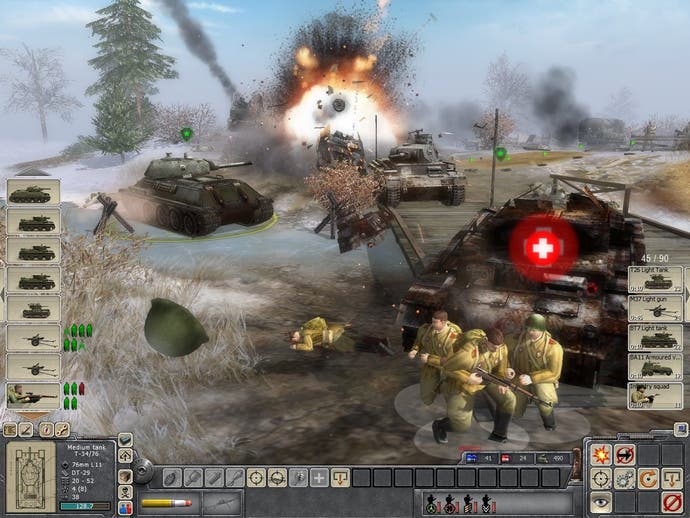Men of War
Company of Heroes has company.
Corpses. Every Men of War battlefield ends up dotted with dozens of them. If they could speak, if they could tell us about their last moments of life, their stories would be as distinct as they were dramatic:
"I was killed by a 20mm cannon shell that punched through the henhouse I was sheltering behind." "I was sniped while trying to scavenge medical supplies from a crashed transport plane." "I was run-over by an out-of-control staff car." "I was in a half-track that plunged through the ice on a frozen river." "I was blown to pieces by a mortar bomb while trying to fix a tank turret." "I was exiting a blazing Panzer when I stepped on an anti-personnel mine." "I was on sentry duty when someone shot me with a silenced pistol, then stole my hat."
Men of War makes the 1939-45 havoc proffered by other real-time strategy games - even Relic's classic Company of Heroes - seem drab and predictable. Its fragile and flammable scenery, extravagant physics, resourceful AI and awesome scale and intricacy combine to create chaos so brutal even Hieronymus Bosch and the Chapman Brothers would blanch.
For those new to the Best Way approach (this is the third high-quality WWII tactics title built with the developer's remarkable GEM engine), play revolves around the spectacular antics of incredibly versatile soldiery with incredibly big pockets. Whether the force at your disposal is one man or fifty, every grunt has his own capacious RPG-style inventory and will happily operate any vehicle or artillery piece, however foreign or complex. If you choose to, you can guide troops around the battlefield with traditional clicks, secure in the knowledge they'll return fire or seek cover if threatened. Alternatively, if you fancy getting a little closer to the gore and glory, you can try your hand at something called Direct Control.
Picture the scene: I've been tasked with taking a German-held monastery in some godforsaken corner of the Ukraine. None of my tanks survived the initial thrust, and the majority of my infantry now lie lifeless amongst the craters and rubble. Only one gutsy Ivan has made it into the first line of enemy trenches. After he's finished bandaging his wounds and rifling the pockets of some nearby corpses, I click the Direct Control button and start guiding him through the trench network with cautious cursor keys. The mouse pointer is his crosshairs. When I swing it onto a target and dab the left mouse button, his submachinegun barks and another grey-garbed foe slumps to the ground in a cloud of crimson.

Up ahead is an enemy gun emplacement ringed with stout sandbags. They haven't seen my one-man Red Army. I sneak him closer, select a pilfered stick grenade, then, using the mouse pointer to target a spot in the midst of the crouching gunners, press and hold the left mouse button. A less seasoned campaigner would have just hurled and hoped. I know from experience that it pays to cook off grenades for a few seconds giving victims no time to dive clear. The potato masher sails over the sandbag barrier and detonates hurling bodies and wreckage high into the air.
Direct Control allows for that extra bit of finesse. It also dissolves at a stroke that emotional distance between player and unit we tend to take for granted in strategy games. In short: it's ace.
One of the few things I disliked about Best Way's last effort, Faces of War, was the feverish intensity of many of the missions. The action came so thick and fast there was often little opportunity for Direct Control, fancy tactics, or gratifying loot-gathering. Men of War's four meaty mission sequences feel far more balanced. Yes, there are engagements so vast and bloody they leave you twitching like a shell-shocked hare, but these tend to be intelligently interspersed with more measured mayhem. For every "Hold this sector at all costs" bloodbath, there's a slower "Reconnoitre that village" or "Rescue those prisoners" jaunt. A few of the scenarios are so slow and stealthy they almost feel like Commandos outings.

